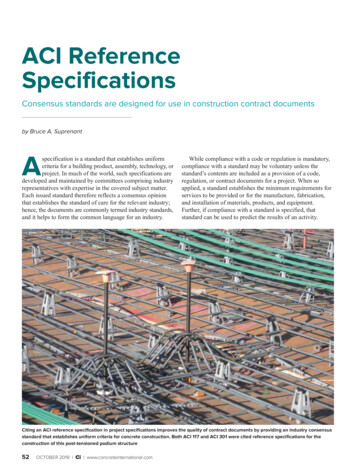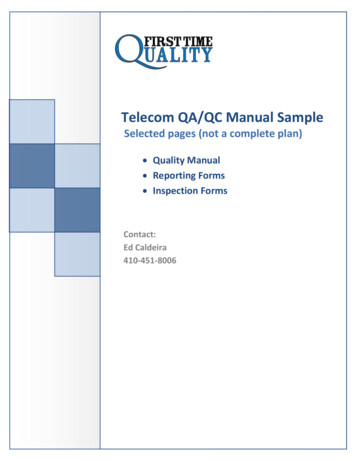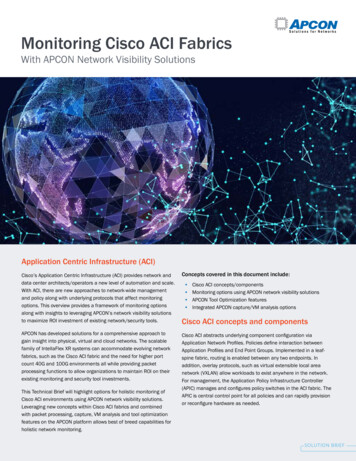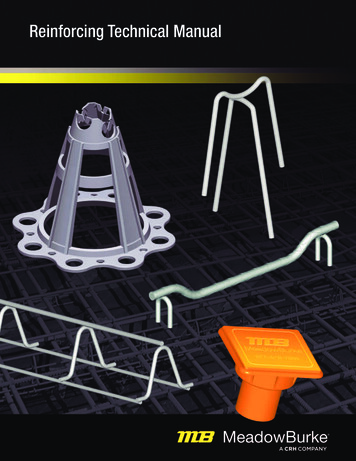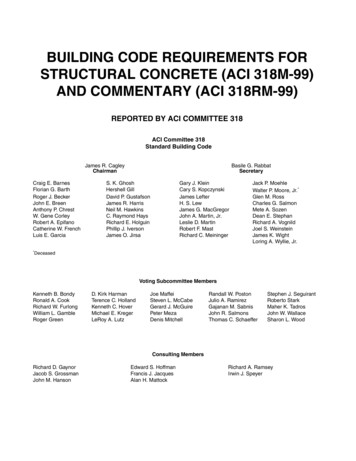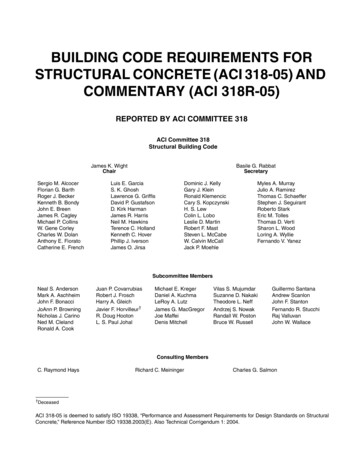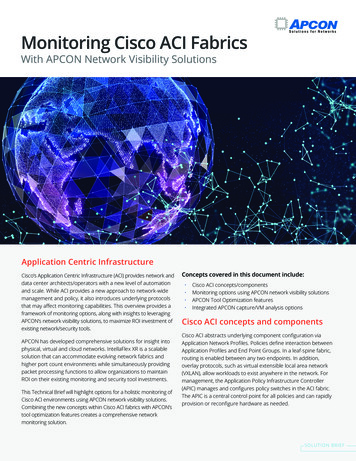
Transcription
Banking ona Real-TimeBalanceSystemLeveraging ACI EnterprisePayments Platform for a real-time balancesystem solution
Overcoming theChallenges of LegacyPayment Systems1With advancements in delivery technology, new payment channels were addedby banks to compete for the consumer’s banking relationship. These newchannels included ATMs, online banking, eCommerce, point of sale, ACH, wiretransfer and telebanking. Each has its own front-end, channel-specific solutionand is connected to the core banking system for final authorization against thecustomer’s available balance. In response to this advancement, some banksdeveloped an intraday balance system.Today, at most banks worldwide this same architecture developed over a 50-yearspan still exists. The in-house written software behind both core and intradaybalance systems are, in most cases, ultra-legacy, with many written in theoriginal “assembler” language of the late 1960s blended with other languages,such as COBOL, as they were enhanced for new channels.These core banking and intraday balance systems need to be modernized forimmediate P2P, P2B, B2P and B2B payments through both in-country gateways(e.g., U.S.: Clearing House and Zelle), as well as providing a solution for “Open APIbanking” (e.g., PSD2 in Europe). Each of these new channels will be integratedthrough messaging interfaces into the core and intraday balance system to get anauthorization against a single “available balance” for all channels.Modernization Needs Real-Time, Something Legacy Systems Cannot Provide Most systems operate on centralized IBM mainframe technology, one of themost expensive platforms to process transactions in a continuously availableenvironment. All new products and integration points require coding events in multiplelegacy environments. Personnel resourcing is difficult and expensive. Interoperability with other systems within the bank requires significantinvestments of time and resourcing. Maintenance of legacy environments and underlying architectures forintegration and interoperability eats up much of the IT budget.Typical Bank Payments EcosystemFront-end, channel-specificsoftware for card-basedtransaction processingFRONT-ENDHARDWAREIBM MainframeTellerDebit cardCard ont-End,Channel-SpecificSolutionAccount #BalancesCredit ScoreBatchOnlineCIFOver DraftCoreBankingSolutionAccount #BalancesBalancesDevices,ATM & POSIBM MAINFRAME (SYSTEM Z)2
2Examining ChangeDriversFor Business OwnersBusiness owners need to create additional revenue through new products andservices sold to grow market share. These business owners need to rapidly deploynew capabilities in the market to effectively combat the increasing competitivepressures posed by competitors and new entrants in the payments market.For Technology OwnersThe drivers for technology owners are many and complicated, with the primarydrivers being to evolve IT infrastructure, reduce IT spend, develop interoperability,and manage risk and convergence. Tech owners must also evolve platforms ina way that leverages legacy systems, creating a stepping stone which bettersupports the new modern payment services today’s business demands — allwithout sacrificing availability and performance.3How Banks Can Takethe First Step toModernizationACI’s Active, Real-Time Balance Solution/ConfigurationThe “real-time balance solution” does not replace the core or intraday balancesystem. Instead, it leverages the “API layer” of ACI’s payment engines to servicemore than just the card-based transaction space. All banking transactions needing24x7x365 availability of a payments authorization system with customer balancecapabilities are routed to the ACI Enterprise Payments Platform. The ACI EnterprisePayments Platform then normalizes all the transactions to one messagingformat, converts all customer form factors to an account number structure forauthorization purposes and sends them to the intraday balance system.The ACI Enterprise Payments Platform sits between the transaction acquiringsystems (channel-specific solutions) and the bank’s core or intraday balancesystem. If they become unavailable or respond too slowly to a payments request,the ACI Enterprise Payments Platform will stand in and authorize the transactionbased upon the balance it has on file, in real time. The bank’s customer gets thehighest levels of service and is completely unaware that the core infrastructureof the bank is unavailable.ACI ENTERPRISE PAYMENTS PLATFORM ACTS AS THE“ALWAYS-ON, REAL-TIME BALANCE” FAIL-SAFE SYSTEMFOR PAYMENT TRANSACTION PROCESSING.3
Real-Time Balance ymentsTellercorporateUP Framework ACI Enterprise Payments PlatformStore &ForwardCustomer& BalancesBank HostBalance Authorization SystemMemo-Post System4BalancesThe India RevolutionIndia is one of the most obvious examples of how these digital overlay servicescan create an explosion in cashless payments, as well as drive the adoption ofinstant payments specifically. The launch of the Unified Payments Interface(UPI) was designed to enable simple real-time payments for consumers andmerchants. UPI has focused on the consumer purchases use case and solvingchallenges in the customer experience.And the proof is in the pudding. Banks offering UPI services in India report thatthese transaction volumes are growing faster than cards, with some researchpredicting non-card payments such as UPI, mobile wallets and Rupay cards — adomestic card payment gateway launched three years ago — to quickly accountfor two-thirds of the digital payments market by 2027.1UPI enables service providers, such as Paytm, to leverage UPI capabilitiesthrough banking partners. Taking this approach, Paytm has reported a seven-foldgrowth in the number of transactions over the last six months. Perhaps mostinterestingly, Paytm also reports that 50% of bill payments in India are now beingmade using their service.As can be seen in the chart below, UPI has seen phenomenal growth asconsumers and businesses alike latch onto the benefits of instant and openpayments. UPI started with support for only P2P transactions, but put in placekey capabilities like “Collect” (an RfP concept as part of the UPI 2.0 launch inSeptember 2018). These new capabilities successfully target the needs of themerchant community.4
Reports on merchant UPI transactions vary between 100 to 120 million permonth, while other experts in the industry are seeing this rise even faster. Withthe likes of WhatsApp, Google Pay, PhonePe (owned by Walmart) and now themighty Amazon all offering instant and open payments between consumers andmerchants, we are going to see continued growth in these types of transactions.India as a society seems well-positioned to capitalize on real-time paymentstransactions, thanks in part to the positive consumer attitudes toward newpayment methods: 88% 2 of people are willing to adopt new digital payments.5ACI’s Overall PaymentsSystem Strategic ValueThere is a need in today’s market to have a consistent, proven payments solutionthat can address the customer identification, authentication and authorizationof any payments transaction from any endpoint. Enabling this using a flexiblearchitecture on commodity hardware, database and O/S for all payment enginefunctions is key to modernizing payments infrastructure. The ACI EnterprisePayments Platform delivers choice in how banks provide what customers expect:an always on, accurate, real-time balance.Learn more about how the ACI Enterprise Payments Platform can help you toensure a return on investment from open and real-time banking.5
ACI Worldwide is a global software company that provides mission-criticalreal-time payment solutions to corporations. Customers use our proven,scalable and secure solutions to process and manage digital payments,enable omni-commerce payments, present and process bill payments, andmanage fraud and risk. We combine our global footprint with local presenceto drive the realtime digital transformation of payments and commerce.LEARN MOREwww.aciworldwide.com@ACI Worldwidecontact@aciworldwide.comAmericas 1 402 390 7600Asia Pacific 65 6334 4843Europe, Middle East, Africa 44 (0) 1923 816393 Copyright ACI Worldwide, Inc. 2021ACI, ACI Worldwide, ACI Payments, Inc., ACI Pay, Speedpay and all ACI product/ solution names aretrademarks or registered trademarks of ACI Worldwide, Inc., or one of its subsidiaries, in the United States,other countries or both. Other parties’ trademarks referenced are the property of their respective owners.ATL1122 03-21
domestic card payment gateway launched three years ago — to quickly account for two-thirds of the digital payments market by 2027.1 UPI enables service providers, such as Paytm, to leverage UPI capabilities through banking partners. Taking this approach, Paytm has reported a seven-fold growth in the number of transactions over the last six .

